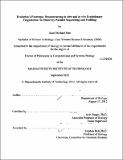| dc.contributor.advisor | Aviv Regev. | en_US |
| dc.contributor.author | Funt, Jason Michael | en_US |
| dc.contributor.other | Massachusetts Institute of Technology. Dept. of Biology. | en_US |
| dc.date.accessioned | 2013-03-01T15:05:25Z | |
| dc.date.available | 2013-03-01T15:05:25Z | |
| dc.date.copyright | 2012 | en_US |
| dc.date.issued | 2012 | en_US |
| dc.identifier.uri | http://hdl.handle.net/1721.1/77442 | |
| dc.description | Thesis (Ph. D. in Computational and Systems Biology)--Massachusetts Institute of Technology, Dept. of Biology, 2012. | en_US |
| dc.description | Cataloged from PDF version of thesis. | en_US |
| dc.description | Includes bibliographical references. | en_US |
| dc.description.abstract | Understanding how phenotypes evolve through natural selection is a fundamental question of biology. Microbial evolution studies provide the rare opportunity to experimentally elucidate the changes that allow an organism to adapt to novel conditions. In an in vitro experimental evolution system, cells evolve in response to a lab-controlled selective environment. In such experiments, the evolved strains may have no fitness-gain in non-stressed conditions, but outperform their progenitors in the selective growth conditions. A complementary in vivo system is monitoring the evolution of drug resistance in microbial pathogens. Identifying the mutations underlying such evolved phenotypes have typically been limited to the identification of regions of interest by low-resolution techniques such as classical genetics or microarray mapping followed by sequencing, and many relevant genes may remain undetected. The recent development of technologies for cost-effective whole-genome resequencing offers the opportunity to comprehensively study evolution in action. Here, I present a combined experimental and computational strategy to detect and study recurrent genetic aberrations accompanying adaptive evolution in Saccharomyces cerevisiae and Candida albicans by whole-genome re-sequencing of evolved strains using Illumina technology. We sequence parental and evolved strains from multiple evolutionary trajectories under the same selective pressure. Our computational approach focuses on the detection of recurrent aberrations - ranging from SNPs to larger variations. We remove variants present in parental strains as background and catalogue subsequent aberrations that persist and co-occur with phenotypic changes. Likely functional changes are identified by recurrence across independent evolutionary time courses. In S. cerevisiae we identify those mutations that are responsible for evolved, adaptive phenotypes, as well as demonstrate that independently arising adaptive alleles, when in the same genetic background, reduce hybrid viability. In C. albicans, we show both large and small recurrent variations that are highly associated with acquisition of fluconazole resistance. Our approach elucidates the function and evolution of key systems in a key model organism and an human pathogen. More generally, our methodology is applicable to a broad range of species, allowing us to trace phenotypic evolution from bacteria to human cancers. | en_US |
| dc.description.statementofresponsibility | by Jason Michael Funt. | en_US |
| dc.format.extent | 258 p. | en_US |
| dc.language.iso | eng | en_US |
| dc.publisher | Massachusetts Institute of Technology | en_US |
| dc.rights | M.I.T. theses are protected by
copyright. They may be viewed from this source for any purpose, but
reproduction or distribution in any format is prohibited without written
permission. See provided URL for inquiries about permission. | en_US |
| dc.rights.uri | http://dspace.mit.edu/handle/1721.1/7582 | en_US |
| dc.subject | Biology. | en_US |
| dc.title | Evolution's footsteps : reconstructing in vitro and in vivo evolutionary trajectories via massively parallel sequencing and profiling | en_US |
| dc.type | Thesis | en_US |
| dc.description.degree | Ph.D.in Computational and Systems Biology | en_US |
| dc.contributor.department | Massachusetts Institute of Technology. Department of Biology | |
| dc.identifier.oclc | 826514496 | en_US |
